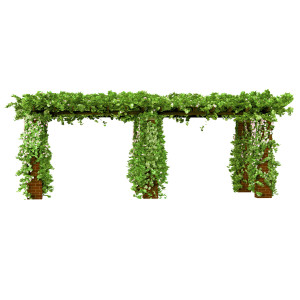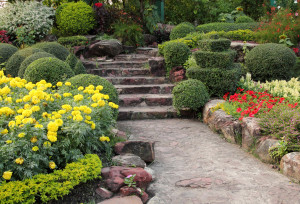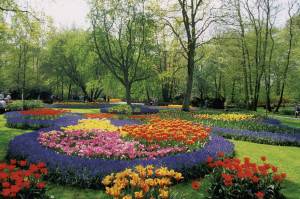
If you enjoy being out and working in your yard, than you like nothing more than the feeling you get when you finally get to sit back and gaze upon the fruits of your labor. Planning and planting a landscape – is no easy feat…if you’ve tried, you know this to be true! The chances for error are high when you aren’t a professional. It is easy to make a mistake in understanding the environment and sun best suited for a plant or shrub, thus causing no growth or even killing your plant. Just as easy a mistake is understanding growth and spacing – for example, your perennial grew far bigger than you expected and now dwarfs and conceals another plant you love. These mistakes may seem small, but after the time and energy it takes to install a garden – no one wants replace or reinvest in new plantings every year.
For you DIY landscapers, we have assembled a list of 8 design principles from a landscape design expert, that will help you to keep your landscape design and installation as fail proof as possible.
Feature adapted from an original article in Garden Design Magazine “8 LANDSCAPE DESIGN PRINCIPLES FOR RESIDENTIAL GARDENS” By Rob Steine. Read the full story here.
Let’s start with two rules that can kick-start the process of laying out a landscape, then move on to guidelines that help in scaling the proportions of a garden’s elements and, finally, to choosing and using the right plants.
01: OBEY THE “LAW” OF SIGNIFICANT ENCLOSURE

Practice the “law of significant enclosure” when scaling your space
Yes, this one’s a “law,” not just a rule! It addresses the root meaning of garden, which is “enclosure.” This, to me, is absolutely critical in creating a sense of refuge and of feeling oneself within nature’s embrace. The law of significant enclosure says that we feel enclosed when the vertical edge of a space is at least one-third the length of the horizontal space we’re inhabiting. Probably derived from behavioral psychology studies…
For example, if a patio area was 17 feet wide – the hedge should be at least 6 feet. Of course, there are times when the point of a landscape design is a monumental sense of scale or view, but the best gardens, whatever their size, modulate a feeling of enclosure and openness, and this rule will help.
02: FOLLOW THE REGULATING LINE

A regulating line will keep symmetry in your design
My formal architectural education also introduced me to the concept of the “regulating line.” The idea is that an element of architecture (for example, a doorway, or a building edge, even a window mullion) or a distinctive landscape feature (prominent tree, existing pool, property boundary) can “generate” an imaginary line that helps connect and organize the design. For example, in laying out one backyard, I projected the lines of its building addition into the garden space and then aligned the swimming pool and wooden walkway with those lines. The result is orderly and cohesive, even after being softened with planting.
“A regulating line,” wrote the great architect (and theoretician) Le Corbusier, “is an assurance against capriciousness…It confers on the work the quality of rhythm…The choice of a regulating line fixes the fundamental geometry of the work….”
Le Corbusier hits on the two aspects (a bit paradoxical, perhaps) that make the regulating line so valuable. First is the idea of underlying order: that the garden, for all its naturalness, or wildness, is founded on strong principles—what’s sometimes known in garden circles as “good bones.” Second, that regulating lines—at least as I employ them—are subjective; it’s the designer who identifies and manipulates them to create the garden. And I’d say that the use of the regulating line, more than any other concept, separates professional from amateur design.
03: USE THE GOLDEN RECTANGLE TO GET PROPORTIONS RIGHT

Flowerbeds with a good ratio – 5’x8′ for example, look and feel right
Certain rules help us refine design. One is the Golden Ratio which is a ratio of proportion that’s been observed in everything from the Great Pyramids at Giza to the Greek Parthenon and has been used throughout history as a guide to a pleasing sense of balance and order. The practical application that I make of the Golden Ratio involves its sibling, the Golden Rectangle, in which the ratio of the short side to the long side is equal to the ratio of the long side to the sum of both sides (a/b = b/a+b)—you probably didn’t know that landscape architects had to learn math. Numerically, the Golden Rectangle ratio is close to 1: 1.6, a proportion I regularly use to lay out terraces, patios, arbors, and lawns. The raised beds in my vegetable garden are 5 by 8 feet. It’s a rectangular proportion that always looks good—they don’t call it golden for nothing!
04: TURN TO THOMAS D. CHURCH WHEN DESIGNING STEPS

Stairs should be proportioned correctly
Another ratio may even be platinum: That’s what I’ve always called the rule for step design advocated by landscape architect Thomas D. Church, often credited with creating the California style. Laid out in his seminal work Gardens Are for People, it says simply that twice the height of the riser plus the tread should equal 26 inches. That means that if the riser is 5 inches, the tread (what you walk on) should be 16 inches. All I can say is that the rule is true, and I’ve used it from steep canyon faces to gentle changes of patio levels. A useful corollary states that 5 feet is the minimum width for two people climbing steps side by side.

Don’t underestimate the space you will need under your pergola or within your patio space
05: SIZE MATTERS
A final rule related to scale and the sculpting of space is this: Go big. Faced with a decision to make a staircase wider or narrower, a pool longer or shorter, a pergola higher or lower, the answer is almost always the former. In my own garden, I remember laying out an arbor, with its posts 10 feet high, and listening to trusted friends wondering whether it wasn’t “a little too tall.” Thankfully I stuck to my guns, and some 18 years later, wreathed in wisteria and anchored at the ground by clusters of pots, the arbor seems just right.
06: PLANT BIG TO SMALL

Plant your large items, then move down in size
It’s with plants, probably more than any other element of gardens, that the infinite variation and fickleness of nature is most evident—and so perhaps, they are the trickiest to prescribe rules for. And yet, successful planting is the crowning touch of a garden. Three rules have always served me well.
First, is to plant big to small: start with trees, then shrubs, then perennials, then ground cover. This is important not only in a compositional way (seeing the bigger forms first gives a better sense of the overall structure), but in a completely practical sense. Setting a big tree may require machinery or at least multiple gardeners and ample space for maneuvering and stationing amendments and soils; it would be sad to damage or undo some newly planted bed. This seems so obvious, but for lots of gardeners (the author included) a block of fresh perennials may be impossible to avoid planting right away. Be strong; resist the temptation.
07: PLANT IN MASSES
While there is much to be said for the cottage garden, with a rich array of varied planting (indeed, it’s the real master gardener who can pull this off),

Larger groupings of the same element are very eye appealing
there is a power to seeing a quantity of one plant that is genuinely affecting. Russell Page, one of the great twentieth-century landscape designers said it well: “the most striking and satisfying visual pleasure comes from the repetition or the massing of one simple element. Imagine the Parthenon with each column a different kind of marble!”
I remember as a beginning garden designer in California being taken aside by my mentor, a transplanted Englishwoman who owned the nursery, walking through a vast block of salvia, and being told that I could, if I liked, use 30 of them—not the three or five I’d typically been planting. It was a liberating moment.
08: REMEMBER THIS ABOVE ALL

Make sure your are digging large enough holes for plants to thrive
Maybe my favorite rule of all time, all the more charming for its need to be adjusted for inflation: It’s better to plant a 50-cent plant in a $5 hole, than a $5 plant in a 50-cent hole. There is no greater planting wisdom. No matter how brilliant a plan one conceives, if the plants are not well planted—at the right height, in a sufficiently sized, and properly amended pit—the results will likely be poor. Some rules just can’t be broken.
Read the full story here.
